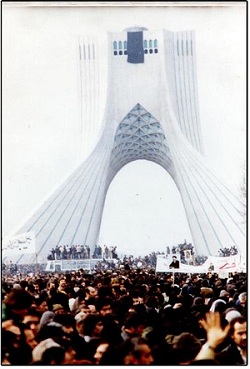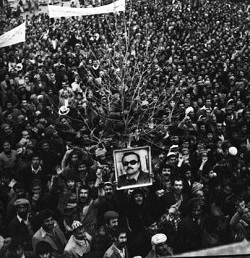 The Iranian Revolution occurred between January 1978 and February 1979, the outcome of this revolution changed the shape of Iran as a nation forever. This revolution also ended Britain and the Soviet Union’s strong interests in the country as Iran tried to gain its own independence away from foreign powers.
The Iranian Revolution occurred between January 1978 and February 1979, the outcome of this revolution changed the shape of Iran as a nation forever. This revolution also ended Britain and the Soviet Union’s strong interests in the country as Iran tried to gain its own independence away from foreign powers.
The Iranian Revolution is a very interesting chain of events as you are about to find out.
Prior to the 1979 Iranian Revolution
Britain and the Soviet Union had long been holding a grasp over in Iran from the nineteenth century because of its location and wealth of oil. In fact the toil between the two nations was a part of “The Great Game” where they jostled for power in central Asia.
In 1941 with the Soviet Union and Britain now Allied in the Second World War, but the Iranians were showing sympathy to Hitler and Germany so together the Soviet and British invaded Iran. This move allowed the nations to secure the railway and depose the Shah putting the Shah’s young son as the new Pahlavi Shah.
In 1953 the British flex their political power again in Iran as the Prime Minister who is extremely popular gains more power from the Shah. The British don’t like the move as he is opposed to their intrusion in Iran. For months the British put pressure on the Shah to dismiss the Prime Minister but does not do it as he is worried about public opinion given the high regard the Prime Minister is held in with the people.
When the Prime Minister dissolves parliament and starts to run everything on his own the Shah dismisses him but the Prime Minister refuses to move. The Shah moves into a state of panic and leaves Iran but Britain and France overthrow the Prime Minister and the Shah returns to Iran.
31sxt December 1961 a high ranking Marja passes on and a new Marja is put in his place, this is Grand Ayatollah Sayyed Ruhollah Mostafavi Moosavi Khomeini.
As soon as he is made Marja Khomeini starts organizing political opposition to the Shahs bills. In 1962 the Shah puts a bill through called the Local council election bill that would allow women to vote and non Muslims run in elections. Khomeini rallies the religious powers and the bill is completely abandoned.
1963 sees Khomeini gain more strength as the Shah tries to put forward his “White Revolution” of a six point bill. Khomeini again gets his political council together and they strongly denounce the bill and say the Shah is doing America and Israel’s bidding. This time the Shah sends a column of military to Qom where Khomeini is with his men then the Shah makes a rousing speech attacking Khomeini and his men.
After two days Khomeini is arrested under the Shahs orders and anarchy breaks out with the people rising up in protest. Martial Law is introduced and the outcome is many civilians being killed by the armed forces.
In April 1964 Khomeini is released from prison but straight away starts causing concern by making speeches about the Shah. Khomeini is rearrested then deported.
1970 sees Khomeini in Iraq, here he makes a speech about the Shah and the outcome is that its made into a book that is then smuggled and distributed in Iran.
In 1975 the uprising of 15 Khordad occurred where students hold a demonstration in the Feyziyeh madreseh. This demonstration gains support from people outside and continues for three days until military intervention quashes it.
The Iranian Revolution
The Iranian Revolution officially starts on January 7th 1978.
An article appears in a newspaper in Iran written by the Information Minister Daryoush Homayoun where he states Khomeini as being homosexual and carrying out many crimes. Two days later mass demonstrations happen in Qom, these demonstrations escalated to the point that the armed forces kill between 10 and 72 civillians.
February 18th sees marches across the country in honour of those who died in the 7th January demonstrations. In the city of Tabriz this becomes violent with armed forces killed up to 100 civilians.
March 29th sees more marches in honour of those who died in the Tabriz demonstration and again civilians are killed, this time in Yazd.
May 10th sees another date full of honour marches, this time for the killings in Yazd. While civilians are not killed the armed forces break into the home of Ayatollah Kazem Shariatmadari, there they kill a follower in front of the Ayatollah and he changes to oppose the Shah.
On August 6th the Shah makes a public address saying that within a year Iran would have free and fair elections. The Shah thought this would reduce the civil unrest but six days later another demonstration occurs in Isfahan with many demonstrators killed.
August 19th is the worst day of the revolution with 477 killed in arson fire at Cinema Rex in Abadan. The Shah and his men blame Khomeini and he blames them, no one knows who actually caused it.
On September 4th, during the Eid celebration at the end of Ramadan, thousands of Khomeini supporters flock to Tehran for a demonstration. By September 8th demonstrations are still ongoing and the Shah responds with super military might including tanks and helicopters, 88 are killed and the day is dubbed “Black Friday”.
To support Iran, Iraq embargoes the home of Khomeini in Iraq, Khomeini tries to flee to Kuwait but is turned away at the border, and this is on the 3rd October. By the 6th October Khomeini is on his way to Paris, France where he settles.
 On 11th October the press of Iran strike.
On 11th October the press of Iran strike.
October 16th sees peaceful demonstrations and marches to remember those who died in Black Friday; this ends up with killings in a mosque. Strikes in all areas of government happen because of the deaths.
November 5th sees angry protests which result in protesters burning buildings, while this is going on students protesting in the university in Tehran are killed by armed forces who storm the building.
November 27th sees many people in a state of ecstasy as after seeing Khomeini’s face in the moon, thus giving more credibility to Khomeini.
Over the 10th and 11th December around 17 million people across Iran march in support of Khomeini and demanding the Shah steps down. This move coincides with a 17 point resolution to make the Ayatollah the leader of Iran.
January 12th sees Khomeini make his “Revolutionary Council” to manage the removal of the Shah and the revolution to do so. Four days later the Shah leaves the country and a week after the Royal Council is dismissed.
Khomeini returns to Iran with millions lining the street in celebration, Ayatollah Khomeini is now leader of Iran and the Iranian people.
